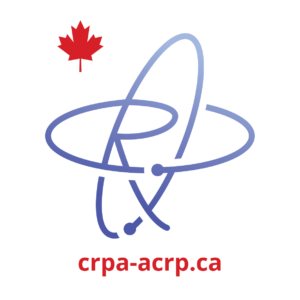Concours de communications étudiantes Anthony J. Mackay 2023

Chaque année, le Comité des étudiants et des jeunes professionnels organise, en combinaison avec le congrès annuel de l’ACRP, le concours de communications étudiantes Anthony J. MacKay. Le concours est ouvert à toutes les étudiantes et tous les étudiants inscrit(e)s à temps plein dans un programme relié aux sciences des rayonnements, dans un établissement d’enseignement (collège ou université) canadien et le sujet est intentionnellement gardé très général afin de permettre la participation d’étudiant(e)s provenant de disciplines diverses.
De toutes les participations reçues, trois finalistes ont été retenu(e)s et auront l’occasion de présenter leurs travaux au congrès lors d’une séance plénière. Les présentations seront jugées sur place, et le nom de la gagnante ou du gagnant sera annoncé pendant le banquet du congrès. La lauréate ou le lauréat recevra le trophée Anthony J. MacKay, verra son article publié dans le Bulletin de l’ACRP et recevra un prix de 250 $ en espèces.
Les finalistes de cette année
Bryce Nelson
candidat au doctorat en oncologie, Université de l’Alberta
Production de Pb 203 par cyclotron à haut rendement à l’aide d’une cible solide scellée de Tl 205
 Mackenzie Tigwell
Mackenzie Tigwell
étudiante à la maîtrise en sciences des rayonnements, Université McMaster
Facteurs contribuant à la dégradation des microsphères Ho 166/PLLA
Mackenzie termine sa maîtrise en sciences des rayonnements et physique médicale à l’Université McMaster. Sa recherche porte sur la production de microsphères d’acide polylactique à base d’holmium, au réacteur nucléaire de McMaster. Elle est une défenseure de l’accessibilité aux sciences et participe à divers projets de communication sur le nucléaire. Elle a également publié deux livres, A Guide to Radiation for the Everyday Scientist et ABCs of Nuclear Science afin d’expliquer ces sujets en langage claire et simple. Mackenzie a coordonné des événements spéciaux pour Let’s Talk Science où elle a organisé de nombreux symposiums de recherche, dont Let’s Talk Nuclear. Elle est passionnée par le domaine nucléaire et est ravie à l’idée de développer sa carrière dans cette industrie.
 Nikhil S. Patil
Nikhil S. Patil
candidat en médecine, Université McMaster
Nikhil Patil est un étudiant en dernière année de médecine à l’Université McMaster qui s’intéresse à la radiologie et à la radioprotection. Il a préalablement étudié l’informatique de la santé et la physiologie et il a toujours été intéressé par le croisement des soins de santé et la technologie. Durant ses études en médecine, il a rédigé plus de quinze articles publiés dans des revues à comité de lecture et il espère continuer à contribuer au domaine de la radiologie universitaire.
Abstracts
Entrants are required to submit an abstract of no more than 750 words on a topic that is related to some aspect of radiation; the topic is intentionally kept broad to encourage participation from a wide range of students. Following are the abstracts submitted by this year’s finalists.
Production de Pb 203 par cyclotron à haut rendement à l’aide d’une cible solide scellée de Tl 205
Bryce Nelson, PhD candidate in oncology, University of Alberta
Coauthors
- John Wilson, Jan Andersson, and Frank Wuest, University of Alberta
- Jonathan Doupe, Alberta Health Services
- Michael Schultz, University of Iowa
Résumé
La théranostique en médecine nucléaire consiste à marquer un vecteur de ciblage biologique d’abord par un radionucléide pour de l’imagerie diagnostique, puis par un radionucléide émetteur de particules pour une thérapie ciblée par ce radionucléide. Un essai clinique récent utilisant le Pb 212-DOTAMTATE pour traiter des tumeurs neuroendocrines métastatiques a découlé en un taux de réponse global de 80 % chez les patients, excédant significativement les traitements standards. Cependant, les examens diagnostics pour suivre la thérapie avec le Pb 212 ont été effectués avec les radiotraceurs conventionnels fluor 18 et gallium 68. Ceci n’est pas optimal puisque ça pourrait mener à l’irradiation involontaire de tissus sains par des particules α. L’objectif de cette étude était d’élaborer une façon de produire un haut rendement de Pb 203 par cyclotron en utilisant le matériau cible enrichi par l’isotope Tl 205 et la réaction Tl 205(p,3n) Pb 203 comme alternative à la production d’une énergie plus faible par le biais de la réaction Tl 203(p,n) Pb 203.
Introduction
Nuclear medicine theranostics involves labelling a biological targeting vector first with a radionuclide for diagnostic imaging, followed by a particle-emitting radionuclide for targeted radionuclide therapy. Lead-212 (Pb-212, t1/2 = 10.6 h) is a particularly attractive therapeutic radionuclide due to its payload of one α and two β– particles in its decay chain and the rapid decay of its progeny to stable Pb-208.
A recent clinical trial (Delpassand et al., 2022) using [Pb-212]Pb-DOTAMTATE to treat metastatic neuroendocrine tumours resulted in an 80% overall patient response rate, significantly exceeding standard-of-care treatments. However, diagnostic scans to track Pb-212 therapy were performed with conventional fluorine-18 and gallium-68 radiotracers. This is suboptimal, as dissimilar chemistries between the diagnostic and therapeutic radionuclides could result in different radiopharmaceutical biodistribution, potentially leading to unintended α-irradiation of healthy tissues.
Pb-212 is ideally paired with the chemically identical lead-203 (Pb-203, t1/2 = 51.9 h) to provide diagnostic SPECT imaging using the 279 keV (81%) gamma-photons emitted during Pb-203 decay. However, worldwide supply of Pb-203 is extremely limited since cyclotron Pb-203 production requires irradiating highly toxic thallium (Tl) material.
Our objectives were to develop a high-yield Pb-203 cyclotron production route using isotopically enriched Tl-205 target material and the Tl-205(p,3n) Pb-203 reaction as an alternative to lower energy production via the Tl-203(p,n) Pb-203 reaction. A robust cyclotron target and efficient chemical purification process must be designed to maximize Pb-203 yield and purity for research and clinical applications, while maintaining stringent radiation and chemical safety given the significant hazards presented to the operators and cyclotron facility.
Methods
Our entire process was designed around preserving radiation and chemical safety. To reduce Tl contamination risk, we employed our patent-pending sealed cyclotron target design that is used to produce other radionuclides.
Tl-205 metal (99.9% isotopic enrichment) was pressed using a hardened stainless-steel die. High purity aluminum (Al) target discs (99.999%) were machined with a central depression and annulus groove.
A Tl-205 pellet was placed into the central depression of the Al disc, and indium wire was laid in the annulus. An aluminum foil cover was then pressed on, cold welding the cover to the disc via the indium with an airtight bond.
Targets were irradiated at 23.3 MeV for up to 516 minutes on a TR-24 cyclotron at proton currents up to 60 μA to produce Pb-203 via the Tl-205(p,3n)Pb-203 nuclear reaction. Following a period of >12 h to allow decay of Pb-204m (t1/2 = 67 min, 899 keV [99%]), the target was removed and Tl-205 was dissolved in HNO3.
A NEPTIS Mosaic-LC synthesis unit performed automated separation using Eichrom Pb resin, and Pb-203 was eluted with HCl or NH4OAc. The waste solution was diverted to a vial for subsequent Tl-205 recovery in an electrolytic cell.
Pb-203 product radionuclidic and elemental purity were assessed by high-purity germanium (HPGe) gamma spectroscopy and inductively coupled plasma optical emission spectroscopy (ICP-OES), respectively. Radiolabelling and stability studies were performed with PSC, TCMC, and DOTA chelators, and Pb-203 incorporation was verified by radio-TLC analysis.
Results
Cyclotron irradiations were performed at a 60 μA proton beam current and 23.3 MeV energy without any target degradation. Automated purification took <4 h, yielding >85% decay-corrected Pb-203 with a radionuclidic purity of >99.9%. Purified Pb-203 yields up to 12 GBq were attained, and Pb-203 was successfully chelated and exhibited >99% incorporation after 120 h in human serum.
Radiation safety implications: In over 100 production runs, there were no cyclotron target station or processing equipment contamination incidents.
Targets were irradiated during the afternoon and removed the following morning to permit decay of short-lived impurities. By allowing >12 hours (>10 Pb-204m half-lives) prior to target removal, operator dose was minimized.
Utilizing high purity Al target components nearly eliminated long-lived activation products, minimizing operator extremity dose when performing target recycling. When combined with a target retrieval shielding cart, a custom-designed lead-shielded processing castle, and an efficient automated process, the operator radiation dose per full production run is <10 µSv (measured by electronic personal dosimeter).
Conclusion
Our recently published high-yield Pb-203 production process significantly enhances Pb-203 production capabilities to meet the rapidly growing worldwide preclinical and clinical demand for Pb-203 radiopharmaceuticals alongside Pb-212 alpha particle therapy.
Since January 2022, we have successfully shipped over 60 batches of Pb-203 to customers and collaborators in 11 locations across 5 countries for research and diagnostic SPECT imaging clinical trials of metastatic melanoma and neuroendocrine tumours. Although we anticipate continually increasing demand, we are confident that our robust process design will maintain operator radiation dose at a small fraction of the permitted annual limit.
Facteurs contribuant à la dégradation des microsphères Ho 166/PLLA
Mackenzie Tigwell, MSc radiation sciences student, McMaster University
Coauthor
- Andrea Armstrong, research scientist, McMaster Nuclear Operations and Facilities, and adjunct assistant professor, McMaster University
Résumé
La théranostique en médecine nucléaire consiste à marquer un vecteur de ciblage biologique d’abord par un radionucléide pour de l’imagerie diagnostique, puis par un radionucléide émetteur de particules pour une thérapie ciblée par ce radionucléide. Un essai clinique récent utilisant le Pb 212-DOTAMTATE pour traiter des tumeurs neuroendocrines métastatiques a découlé en un taux de réponse global de 80 % chez les patients, excédant significativement les traitements standards. Cependant, les examens diagnostics pour suivre la thérapie avec le Pb 212 ont été effectués avec les radiotraceurs conventionnels fluor 18 et gallium 68. Ceci n’est pas optimal puisque ça pourrait mener à l’irradiation involontaire de tissus sains par des particules α. L’objectif de cette étude était d’élaborer une façon de produire un haut rendement de Pb 203 par cyclotron en utilisant le matériau cible enrichi par l’isotope Tl 205 et la réaction Tl 205(p,3n) Pb 203 comme alternative à la production d’une énergie plus faible par le biais de la réaction Tl 203(p,n) Pb 203.
Background
Selective internal radiation therapy (SIRT) has been gaining popularity as a treatment for hepatocellular carcinoma. A beta-emitting isotope is encapsulated in microspheres and injected into the liver via the hepatic artery. Initial treatment options used Y-90 encapsulated in aluminosilicate glass (Barros et al., 2014). Y-90 undergoes pure beta-minus decay with a 64.1 hour half-life. This results in concentrated doses of radiation directly at tumor locations and minimal external dose risk to manufacturing staff, administering physicians, and shielding requirements to ship treatments. However, Y-90 microspheres do not allow for any imaging to track the location of microspheres. Due to this major limitation, other isotopes were considered for selective internal therapy treatments.
Holmium-166/PLLA microspheres can be used for SIRT while remaining imageable via MRI or SPECT (Yamazaki et al., 2020). Ho-166 decays 100% via beta-minus decay followed by gamma ray emissions of 80 keV (6.5%) and 1379 keV (0.9%). Due to Ho-166 half-life of only 26.8 hours, higher specific activity is needed at production. The gamma emissions and higher specific activity cause radiation dose risk to production staff. Additionally, PLLA microspheres are staticky and act like a powder, unlike previous glass versions. This presents additional radiation protection challenges.
There are several considerations during the production and suspension of Ho-166/PLLA microspheres to ensure adequate quality for patient treatment. Neutron irradiation causes damage to microspheres leading to decomposition. This damage is theorized to be caused by temperature, gamma photons, fast neutrons, and/or side reactions of thermal neutron capture (Vente et al., 2009).
Methods
Microspheres were exposed to a range of gamma doses (0 kGy to 800 kGy) using a cobalt-60 source. The microsphere batches were then divided and maintained at temperatures ranging from 20°C to 100°C for at least 4 hours. This created samples with unique combinations of temperature and gamma radiation exposure.
To assess environmental factors in-core, a rig with detachable Pb shielding was engineered. Shielding of 0.25 cm to 1.25 cm were tested for temperature, flux, and sample quality. Microspheres were tested at specific activities ~25 MBq/mg and ~40 MBq/mg.
All samples were suspended in media and imaged at 24-hour intervals. Sample quality was assessed by light microscope imaging with a digital camera attachment. The total number of damaged microspheres was calculated as a percentage of the total.
Results
Temperature showed significant impact on quality. Batches below 55°C had minimal damage (~1% to 4%). The 60°C and 65°C samples represented a significant damage threshold, where damage was at least 2x that of a control sample at suspension (6% to 20%). A damage threshold of 60°C to 65°C coincides with the glass transition temperature (Tg) of PLLA. The 70+ °C batches had extreme levels of damage in all samples, in the range of 80% to 100% damage.
Gamma dose in temperatures below Tg did not show any notable impact on quality except for 600 kGy samples. Samples at 600 kGy showed more damage than 800 kGy samples in almost all trials. The effects of gamma radiation seen in these trials may change for increased dose rates, more representative of environments in-core. Notably, batches exposed only to gamma radiation and temperature did not show degradation over time, normally seen in samples irradiated in-core.
Variable shielding in core had prominent impacts on temperature, neutron flux, and sample quality. The temperature in the rig showed a decreasing trend with the increase of Pb shielding. Temperatures exceeded 60°C in the 0.25 cm shield but dropped to 43°C by the 1.25 cm attachment. Thermal neutron flux decreased with greater Pb thickness for attachments of 0.25 cm to 1.0 cm. The 1.25 cm shield increased thermal neutron flux. Microsphere samples in attachments 0.25, 0.5, and 0.75 were all viable at ~25 MBq/mg. Microsphere samples at ~40 MBq/mg showed unacceptable damage in attachments 0.25 cm to 1.0 cm of PB.
Conclusions
Temperature showed the most drastic impact on quality. The 60/65 °C samples represented a significant damage threshold. This temperature coincides with the glass transition temperature (Tg) of PLLA, which falls in the range of 60°C to 65°C. Ionizing radiation inducing chain scissions reduces Tg and may account for the increasing damage in samples above 200 kGy heated to 65°C. Gamma dose had minimal impact on low temperature samples. Samples irradiated to 600 kGy had more severe damage than other batches and suggests a damage threshold induced by polymer chain-scissions. Further testing is needed for dose-rate impact. Finally, increased Pb shielding of samples was shown to decrease temperature in the sample chamber and alter the thermal neutron flux. These insights inform the selection and equipment production of new reactor sites for Ho-166/PLLA microsphere production.
Aptitude des radiologistes à identifier le bruit et la qualité de l’image dans les fantômes pédiatriques dans un établissement
Nikhil S. Patil, MD candidate, Michael DeGroote School of Medicine, McMaster University
Coauthors
- Scott Caterine, Department of Radiology, McMaster University
- Chris Gordon, Department of Radiology, McMaster University
- John Donnellan, Department of Radiology, McMaster University
Résumé
Les patients pédiatriques exposés aux rayonnements en raison de l’imagerie diagnostique ont un risque accru de développer de futures tumeurs malignes. Les procédures et technologies d’examens radiologiques varient d’un établissement à l’autre, rendant difficile l’élaboration de stratégies universelles pour la réduction des doses de rayonnement. Nous avons mené une étude dans un seul établissement portant sur l’aptitude des radiologistes à détecter les changements dans le bruit de l’imagerie et la qualité du diagnostic à différentes doses de rayonnement lors d’examens avec des fantômes pédiatriques.
Introduction
Pediatric patients exposed to radiation due to diagnostic imaging have an increased risk of developing future malignancies. Radiology scanning procedures and technology vary from institution to institution, making it difficult to come up with universal strategies for radiation dose reduction. We conducted a single-institution study investigating the ability of radiologists to detect changes in imaging noise and diagnostic quality at different radiation doses in pediatric phantom scans.
Methods
One pediatric “phantom” patient of a simulated head, chest/abdomen/pelvis, and abdomen/pelvis was scanned using computed tomography at four different noise index levels. Each image set was scanned four times to create four different series, with each series having a different noise index level. To modify the noise index between image sets, the mAs was modified between each series.
Radiologists at our institution were surveyed for determining relative noise, identifying scans closest to the current standard of practice, and determining scans of diagnostic quality.
Results
Ten radiologists were surveyed. The included participants were academic staff radiologists at McMaster University with 5 to 28 years of experience practising radiology. Six of the included radiologists were pediatric subspecialists, whereas the remaining four were adult radiologists. Similarly, the time spent reporting pediatric specific scans was widely variable, ranging from every day to rarely ever.
Overall, the included participants were able to correctly rank 104/160 series when asked to order the series from least noise to most noise.
- 33/40 responses stated that more than one series were of equal noise, which was not true in any of the phantom scans.
- 11/40 responses stated that the series with the most noise was of diagnostic quality.
- 9/40 of responses correctly identified the series most similar to their current standard of practice.
There was variability in classification accuracy for relative noise between the abdomen/pelvis, chest/abdomen/pelvis, and head scans. Similarly, there was variability in the classification accuracy between the pediatric and adult radiologists.
Discussion
This quality improvement study found that, in general, there was considerable variability in radiologists’ ability to accurately determine the relative noise index of a scan when comparing it to the same scan of a different noise index, as radiologists were only able to correctly rank series from least noise to most noise 60% of the time (104/160).
Furthermore, this study showed that many radiologists report series with a NI higher than the institution standard were of diagnostic quality. This indicates the potential for increasing the noise index in order to reduce radiation dose, without losing diagnostic quality of that image.
Our institution-specific findings are consistent with the literature in that the ability for radiologists to accurately discern scans with higher noise from those with lower noise displays interobserver and international variability.
Interestingly, classification accuracy for relative noise appeared to vary between the abdomen/pelvis, chest, and head scans.
When asked what series was most similar to radiologists’ current standard of practice, there appeared to be a tendency to pick the series with the least noise. Additionally, multiple radiologists found scans to be of equal noise index, when in reality none of the scans had the same level of noise. This strengthens the possibility for increasing the noise index for the purpose of reducing pediatric radiation dose without sacrificing diagnostic quality.
Further investigation is warranted with regards to reducing radiation doses without sacrificing diagnostic quality. Eventually, conducting a similar study with patients would provide the highest quality evidence. Furthermore, we highlight the importance of conducting institution-specific dose reduction studies to improve radiation exposure practices at the institution level, and beyond.
Voir les articles connexes :
Gagnants du concours de communications étudiantes Anthony J. Mackay 2022, 16 février 2023
Concours de communications étudiantes Anthony J. Mackay 2019, 7 juin 2019
Concours de communications étudiantes Anthony J. Mackay 2018, 8 mai 2018
Vous voulez lire d’autres articles comme celui-ci ?
Le Bulletin de l’Association canadienne de la radioprotection (ACRP) est une publication essentielle à tout professionnel de la radioprotection du Canada. Son contenu éditorial procure aux professionnels de la radioprotection les enseignements, l’information, les conseils et les solutions utiles, tous nécessaires pour demeurer à l’avant-garde de la profession.
Abonnez-vous aujourd’hui pour que nous vous envoyions un courriel chaque fois qu’un nouveau numéro est mis en ligne. Revisitez souvent le site entre chaque numéro pour obtenir les mises à jour et consulter de nouveaux articles.
Ne ratez aucun numéro. Abonnez-vous dès aujourd’hui !
Abonnez-vous


 Mackenzie Tigwell
Mackenzie Tigwell Nikhil S. Patil
Nikhil S. Patil
